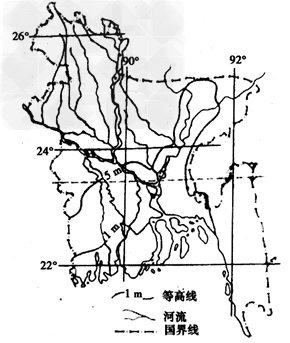下图为某国简图。读图并结合所学知识,回答下列问题。

(2)从地理位置看,该国属于______气候,这种气候的特点是__________________________________________。
(3)该国人口稠密,在地形、气候条件下,大部分地区形成的农业地域类型为______________。
(4)说明该国气候、地形对发展该类型农业的不利影响。
________________________________________________________________________________
(1)印度;地形以平原为主(大部分为大河下游冲积平原和三角洲);地势低平,北高南低
(2)热带季风;全年气温高,降水量大,分雨季和旱季
(3)水稻种植业(季风水田农业)
(4)雨季降水集中(暴雨),地势低平,排水不畅,形成洪涝灾害;(热带季风气候降水变率大,在水稻生长需水量大时)如果雨季来得迟,去得早(或降水偏少),会形成旱灾。
